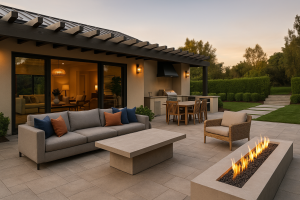In the world of architecture, corbels play a crucial role in adding both structural support and aesthetic appeal to various structures. The use of corbels dates back centuries and has evolved over time to adapt to various architectural styles and construction techniques.
If you’re wondering what is a corbel, this ultimate guide will provide you with a comprehensive overview. We will explore the meaning, definition, types, history, uses, and advantages of incorporating corbels into your architectural designs. We will also provide insights into corbel maintenance and restoration, as well as addressing common questions and misconceptions surrounding this architectural element.
Defining a Corbel
A corbel is a structural element that is used to support weight or provide visual interest in architectural design. It is typically made of stone, wood, or other durable materials and is incorporated into the construction of buildings, bridges, and other structures.
The design of a corbel varies depending on its intended use and the architectural style of the structure. Some corbels are purely functional, designed to support the weight of a load-bearing element such as a beam or arch. Others are purely decorative, added to a building’s façade to enhance its visual appeal.
Corbel Design
Corbels come in a wide range of shapes, sizes, and styles, depending on the era and region of their origin. Some corbels are simply shaped, such as a rectangular block or a curved bracket. Others are intricately carved with decorative motifs, such as animal figures or floral patterns.
| Type of Corbel | Description |
|---|---|
| Scroll Corbel | A corbel with a scroll-shaped design, often used in Romanesque architecture. |
| Dentil Corbel | A corbel with a series of small, tooth-like blocks arranged in a row, often used in classical architecture. |
| Modillion Corbel | A corbel with a bracket-like design that curves outward, often used in Baroque architecture. |
These different types of corbels are often used in conjunction with other architectural features, such as arches, cornices, and pilasters, to create a cohesive and visually appealing design.
History of Corbels
Corbels have a rich history in architectural design, dating back to ancient civilizations. They were originally used as a simple means of supporting structures, such as roofs and balconies. However, over time, corbels evolved to serve both functional and decorative purposes.
One of the earliest known examples of corbel construction is from the ancient Mayan civilization. The Mayans used corbels extensively in the construction of their temples and other monumental buildings. They created these structures by stacking progressively smaller stones on top of each other, with each layer slightly extending outwards, until the desired shape was achieved.
The use of corbels continued throughout history, with notable examples in medieval European architecture. Gothic cathedrals, such as Notre-Dame and Chartres, feature intricate corbel designs, often depicting scenes from the Bible or other religious stories. Renaissance architecture also incorporated corbels as a decorative element, with many Italian palaces featuring elaborate stone corbels.
| Corbel Examples in History | Corbel Characteristics |
|---|---|
| Ancient Mayan temples | Stacking progressively smaller stone blocks to support structures |
| Gothic cathedrals | Intricate designs depicting religious scenes |
| Renaissance palaces | Elaborate stone corbels as decorative elements |
Corbels also played a pivotal role in the construction of castles and fortresses throughout history. They were used to support the weight of walls, turrets, and other defensive structures. Corbels were often incorporated into the design of battlements and crenellations, providing both support and protection.
Today, corbels continue to be utilized in a variety of architectural styles and construction techniques. Their versatility and aesthetic appeal make them a popular choice for both historical restoration projects and modern architectural designs.
Types of Corbels
Corbels come in various types and shapes and are used for different purposes in architectural design. The type of corbel utilized is dependent on factors such as the size and weight of the structure it will support, the desired visual effect, and the construction materials available.
1. Stone Corbels
Stone corbels are commonly found in traditional architecture and are used to support heavy structures such as arches and balconies. They are made from various types of stone, including limestone, granite, and sandstone. One example is the carved stone corbels often seen on Gothic cathedrals.
2. Wooden Corbels
Wooden corbels are frequently used in residential construction due to their versatility and ease of use. They are utilized for both aesthetic purposes and structural support, such as to hold up a roof or to add visual interest to a room. These corbels are available in various types of wood, including oak and maple.
3. Metal Corbels
Metal corbels are commonly used in industrial and modern architecture. They are available in various sizes and shapes and can be made from materials such as steel or iron. Metal corbels are often used to support large structures such as bridges and are known for their durability and strength.
4. Brick Corbels
Brick corbels are used in masonry structures to provide support and to create decorative effects. These corbels are made from the same materials as the surrounding structure and are built into the structure during construction. They are frequently used to support arches and to add visual interest to brick walls.
The type of corbel used in a structure will depend on a range of factors, including the architectural style, materials available, and intended function. Whatever the type, corbels are an essential component in architectural design, providing both aesthetic appeal and structural support.
Corbel Uses in Architecture
Corbels are essential components in architectural designs. They serve both functional and aesthetic purposes, offering support to architectural elements and adding visual interest to structures. Here are some of the common uses of corbels in architecture:
1. Supporting Structures
Corbels are often used to support heavy architectural elements such as arches, balconies, and cornices. They help distribute the weight of these elements and transfer the load to the supporting structure.
| Examples of Corbel Uses in Supporting Structures | Images |
|---|---|
| Supporting arches in medieval architecture |  |
| Supporting balconies in neoclassical architecture |  |
2. Adding Visual Interest
Corbels can also be used purely for their decorative value, adding interest and character to a building’s façade. They come in a range of shapes and sizes, giving architects and designers the freedom to create unique designs.
| Examples of Corbel Uses in Adding Visual Interest | Images |
|---|---|
| Decorative corbels in Victorian architecture |  |
| Ornamental corbels in Gothic architecture |  |
3. Concealing Structural Elements
Corbels can also be used to conceal structural elements such as beams and columns. They are often used in combination with other architectural features to create a unified and cohesive design.
| Examples of Corbel Uses in Concealing Structural Elements | Images |
|---|---|
| Corbels used to conceal beams in Tudor architecture |  |
| Corbels used to conceal columns in Art Deco architecture |  |
Overall, corbels are versatile architectural elements that can be used in a variety of ways to enhance the functionality and aesthetics of a building. They are a testament to the creativity and craftsmanship of architects and builders throughout history.
Corbel Bracket: An Essential Component
Corbel brackets are a crucial element in the construction and design of corbels. These brackets are used to provide additional support and stability to the corbel, ensuring that it can handle the weight of the structure it is supporting. They come in various shapes and sizes, with each design providing unique benefits.
| Bracket Type | Description |
|---|---|
| L-shaped bracket | This bracket is commonly used for smaller corbels and is designed to provide support on two sides. |
| Triangular bracket | This bracket is ideal for larger corbels and provides support from three directions. It is commonly used in the construction of arches and vaulted ceilings. |
| Scroll bracket | This bracket is often used for decorative purposes and can add an intricate and elegant touch to the corbel design. It provides support from one side. |
Corbel brackets are typically made from the same material as the corbel itself, ensuring that they blend seamlessly into the overall design. They are usually constructed from materials such as stone, wood, or metal to ensure that they are strong and durable.
Without corbel brackets, corbels would not be able to support the weight of the structures above them. Additionally, they contribute to the aesthetic appeal of the corbel design, adding to their overall visual impact.
Corbels in Modern Architecture
The use of corbels in modern architecture has continued to evolve, adapting to new construction techniques and design trends while maintaining their essential function as support structures.
One notable trend is the integration of corbels into minimalist designs. In these cases, corbels are often understated, serving a primarily functional purpose while still adding a subtle visual interest to the overall aesthetic.
Another way corbels are being utilized in modern architecture is through the incorporation of technology. 3D printing has made it possible to create intricate corbel designs with greater precision and speed than traditional techniques allowed.
Corbels are also being used in sustainable design practices, particularly in the construction of green roofs. By using corbels to support the weight of soil and vegetation, structures can be made more environmentally-friendly while still maintaining their structural integrity.
Corbels in High-Rise Buildings
Corbels are also becoming increasingly popular in the construction of high-rise buildings. In these cases, corbels are used to support the weight of exterior walls, helping to distribute the load and reduce stress on the building’s foundation.
Corbels can also be used as a decorative element in high-rise buildings, adding an element of visual interest to what might otherwise be an unremarkable surface.
| Advantages of Using Corbels in High-Rise Buildings: |
|---|
| • Greater structural stability |
| • Improved distribution of weight and load |
| • Added visual interest |
Advantages of Using Corbels
Corbels have been utilized in architectural design for centuries. Their structural and aesthetic benefits make them a popular choice for many construction projects. Here are some advantages of using corbels:
| Advantages | Explanation |
|---|---|
| Structural Support | Corbels provide support for overhanging structures, such as balconies, cornices, and arches. They can help distribute weight evenly, reducing stress on the building’s foundation and extending its lifespan. |
| Design Flexibility | Corbels come in a variety of shapes, sizes, and materials, allowing for creative customization. They can be incorporated into both traditional and modern architectural styles, adding unique visual interest. |
| Long-lasting Appeal | Corbels are made from durable materials such as stone, wood, and metal, making them a long-lasting feature in architectural design. Additionally, their timeless design means they won’t become outdated or obsolete over time. |
Overall, corbels are a versatile and functional element in architectural design that offer both structural support and visual appeal. Their design flexibility allows for creative customization and their durability ensures they will remain a valuable feature for years to come.
Maintaining and Restoring Corbels
Corbels are an important part of architectural design, and proper maintenance and restoration is critical to preserving their structural integrity and historical significance. Here are some best practices to consider:
Regular Inspection
Regular inspections should be conducted to assess the condition of corbels. This includes checking for cracks, weathering, and damage caused by pests or moisture. If any issues are discovered, it is important to address them promptly to prevent further deterioration.
Cleaning
Cleaning corbels should be done gently, using mild soap and water, and avoiding harsh chemicals or abrasive tools. Pressure washing should also be avoided, as it can cause damage to the corbel’s surface.
Repairing Damages
If a corbel is damaged, repairs should be made using materials that match the original construction, such as brick or stone. It is recommended to use a professional mason or contractor who is experienced in corbel restoration to ensure the repair work is done properly.
Preserving Authenticity
When restoring corbels, it is important to preserve their authenticity and historical significance. This includes maintaining the original design and materials, as well as respecting any cultural or artistic influences that may have influenced the corbel’s creation.
Frequently Asked Questions about Corbels
As we conclude our guide to corbels in architecture, we’ve gathered some frequently asked questions to provide a comprehensive understanding of this crucial architectural feature. Here are some answers:
Q: What is a corbel?
A: A corbel is a structural and decorative element used in architecture to support weight and add visual interest. It is often made of stone, wood, or brick and is designed to protrude from a wall or column.
Q: What is the purpose of a corbel?
A: Corbels serve a dual purpose of supporting weight and adding aesthetic value. They are commonly used to create overhangs, arches, and other decorative elements in architectural design.
Q: What are the different types of corbels?
A: Corbels come in various shapes, sizes, and materials. Some common types of corbels are bracketed corbels, scroll corbels, and stepped corbels.
Q: How are corbels installed in architecture?
A: Corbels are typically placed between two vertical supports, such as columns or walls. They are secured in place using a metal bracket and mortar or adhesive.
Q: How do you maintain and restore corbels?
A: To maintain corbels, regularly inspect them for damage, clean them gently to remove dirt, and repair any cracks or chips. To restore corbels, consult a professional restoration expert who can assess the extent of damage and recommend the best course of action.
Q: Are corbels still used in modern architecture?
A: Yes, corbels are still widely used in modern architecture. They provide structural support, add visual interest, and can be used to create unique design elements that enhance the overall aesthetic of a building.
Hopefully, this guide has provided you with a comprehensive understanding of corbels in architecture. Whether you’re an architect, designer, or simply someone interested in the history and evolution of architectural design, corbels continue to play a significant role in buildings around the world.










